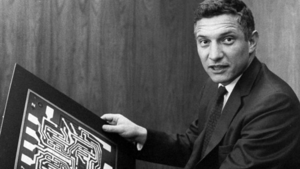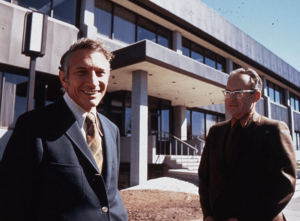Robert Noyce facts for kids
Quick facts for kids
Robert Noyce
|
|
|---|---|

Noyce in 1959
|
|
| Born |
Robert Norton Noyce
December 12, 1927 |
| Died | June 3, 1990 (aged 62) |
| Education | Grinnell College (BA) Massachusetts Institute of Technology (PhD) |
| Occupation | Physicist |
| Known for | Co-founding Fairchild Semiconductor and Intel |
| Spouse(s) | Elizabeth Bottomley Ann Bowers |
| Children | William B. Noyce Pendred Noyce Priscilla Noyce Margaret Noyce |
| Parent(s) | Ralph Brewster Noyce Harriet May Norton |
| Awards | Faraday Medal (1979) Harold Pender Award (1980) John Fritz Medal (1989) |
Robert Norton Noyce (born December 12, 1927 – died June 3, 1990) was an American scientist and business leader. People called him "the Mayor of Silicon Valley."
He helped start two very important companies: Fairchild Semiconductor in 1957 and Intel Corporation in 1968. Robert Noyce is also famous for inventing the first microchip. This invention helped start the personal computer revolution. It also gave Silicon Valley its famous name.
| Top - 0-9 A B C D E F G H I J K L M N O P Q R S T U V W X Y Z |
Early Life and Family
Robert Noyce was born in Burlington, Iowa, on December 12, 1927. He was the third of four sons. His father, Ralph Brewster Noyce, was a minister. He went to several colleges. His mother, Harriet May Norton, was also a college graduate. She was a very smart and strong-willed woman.
Robert had three brothers: Donald, Gaylord, and Ralph. His brother Donald became a respected professor. Robert later created an award to honor great teaching at Berkeley. His brother Gaylord became a professor at Yale Divinity School. He was even arrested for being one of the Freedom Riders during the civil rights movement.
When Robert was five, he beat his dad at ping pong. His mom said, "Wasn't that nice of Daddy to let you win?" Robert felt upset. He said, "That's not the game! If you're going to play, play to win!" Even as a young boy, he wanted to win fairly.
When Robert was twelve, he and his brother built a small airplane. They used it to fly from a stable roof! Later, he built a radio from scratch. He also made his sled motorized. He used a propeller and motor from an old washing machine. His parents were religious, but Robert became less religious later in life.
Education and Discoveries
Noyce grew up in Grinnell, Iowa. In high school, he was very good at math and science. He even took a college physics class. He graduated from Grinnell High School in 1945. Then he went to Grinnell College. He was a star diver on the swim team. He also sang, played the oboe, and acted.
During college, Robert got into some trouble. He and his friends took a pig from the mayor's farm. They roasted it for a party. The mayor was very angry. Robert faced being kicked out of school. But his physics professor, Grant Gale, helped him. The college paid for the pig. Robert was suspended for one semester. He came back in 1949. He graduated with high honors in physics and mathematics. He also won an award for getting great grades with seemingly little effort.
While at Grinnell, Robert was fascinated by physics. Professor Gale showed his class some of the very first transistors. Robert was hooked! Gale suggested he apply to the PhD program in physics at MIT.
Robert's mind was so fast that his friends called him "Rapid Robert." He earned his PhD in physics from MIT in 1953.
Career and Inventions

After MIT, Noyce worked as an engineer at Philco Corporation. In 1956, he joined William Shockley. Shockley was one of the inventors of the transistor. He had won a Nobel Prize. Noyce worked at Shockley's lab in Mountain View, California.
A year later, Noyce and seven other engineers left Shockley's lab. They were called the "traitorous eight." They left because they didn't like Shockley's management style. They then started a very important company called Fairchild Semiconductor. Robert Noyce's strong ideas helped convince the company to create this new division.
In 1958, another inventor, Jack Kilby, created the first hybrid integrated circuit. But in 1959, Noyce independently invented a new type of integrated circuit. It was called the monolithic integrated circuit. This was the first true microchip. It was more practical than Kilby's design. Noyce's chip was made of silicon, while Kilby's was made of germanium. Noyce's design put all parts on one silicon chip. They were connected with tiny copper lines. This made it possible to mass-produce them.
In 1968, Noyce and Gordon Moore left Fairchild Semiconductor. They started Intel. Arthur Rock, a major investor, said Intel needed Noyce, Moore, and Andrew Grove to succeed. Noyce was the visionary, Moore the technology expert, and Grove the management expert.
Noyce created a relaxed work culture at Intel. He treated employees like family. He encouraged teamwork and rewarded it. He didn't like fancy corporate perks. He didn't have a special car or private jet. He wanted everyone to contribute. This style became a model for future Intel leaders.
At Intel, he oversaw the invention of the microprocessor by Ted Hoff. He also oversaw the design of the first commercial microprocessor, the Intel 4004, by Federico Faggin. This was his second big revolution in technology.
Personal Life
In 1953, Noyce married Elizabeth Bottomley. They had four children: William, Pendred, Priscilla, and Margaret. They lived in Los Altos, California. Elizabeth loved New England. So, they bought a summer home in Bremen, Maine. Elizabeth and the kids spent summers there. Robert would visit, but he kept working at Intel. They divorced in 1974.
In 1974, Noyce married Ann Schmeltz Bowers. Ann was the first Director of Personnel for Intel. She was also the first Vice President of Human Resources for Apple Inc.. She now leads the Noyce Foundation.
Robert Noyce stayed active his whole life. He enjoyed reading. He flew his own airplane. He also liked hang-gliding and scuba diving. He believed that microelectronics would keep getting more complex. He wondered what society would do with this technology. In his last interview, he was asked what he would do if he were "emperor" of the United States. He said he would make sure the next generation was ready for a high-tech world. This meant educating everyone, from the poorest to those in graduate school.
Death
Robert Noyce had a heart attack at home on June 3, 1990. He was 62 years old. He passed away at a hospital in Austin, Texas.
Awards and Recognition
In July 1959, Robert Noyce applied for a patent for his integrated circuit. This was just a few months after Jack Kilby's invention. Three U.S. presidents honored Noyce for his invention and its huge impact on the world.
Noyce received many awards. President Ronald Reagan gave him the National Medal of Technology in 1987. In 1989, he joined the U.S. Business Hall of Fame. President George H. W. Bush spoke at the ceremony. In 1990, Noyce, along with Jack Kilby and transistor inventor John Bardeen, received a "Lifetime Achievement Medal."
He also received the Franklin Institute's Stuart Ballantine Medal in 1966. In 1978, he got the IEEE Medal of Honor for his work on the silicon integrated circuit. This was a key part of modern electronics. In 1979, he received the National Medal of Science and the Faraday Medal. He was also chosen as a Fellow of the American Academy of Arts and Sciences in 1980. The National Academy of Engineering gave him the Charles Stark Draper Prize in 1989.
The science building at his old college, Grinnell College, is named after him.
On December 12, 2011, Google honored Noyce with a special drawing on its homepage. This celebrated his 84th birthday.
In 2000, Jack Kilby won the Nobel Prize in Physics. In his speech, he mentioned Robert Noyce three times. He recognized Noyce's contributions to the success of integrated circuits.
Legacy and Impact
The Noyce Foundation was started by his family in 1990. This foundation worked to improve math and science education for students from kindergarten to 12th grade. The foundation announced it would close in 2015.
In 1990, the U.S. Congress created the Robert Noyce National Math and Science Teachers Corps Act. This program helps people become science and math teachers. It gives scholarships to college students studying science, technology, engineering, and math (STEM). In return, these students agree to teach science or math in schools that need teachers the most. They must teach for at least two years for each year they received the scholarship.
Images for kids
See also
 In Spanish: Robert Noyce para niños
In Spanish: Robert Noyce para niños



